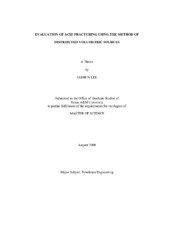| dc.contributor.advisor | Valko, Peter | |
| dc.creator | Lee, Jaehun | |
| dc.date.accessioned | 2010-01-15T00:17:05Z | |
| dc.date.accessioned | 2010-01-16T00:14:50Z | |
| dc.date.available | 2010-01-15T00:17:05Z | |
| dc.date.available | 2010-01-16T00:14:50Z | |
| dc.date.created | 2009-08 | |
| dc.date.issued | 2010-01-14 | |
| dc.identifier.uri | https://hdl.handle.net/1969.1/ETD-TAMU-2009-08-7075 | |
| dc.description.abstract | Acid fracturing stimulation is one of the preferred methods to improve well productivity in carbonate reservoirs. Acid is injected into the fractured zone after a starter fracture is created in the near wellbore area by viscous fluid (pad). This results in propagation of a two-wing crack away from the perforations with simultaneous dissolution etching of the created surfaces. If the created etched surface is non-uniform, then after the treatment ends and the fracture face closes, a high conductivity path may remain in the formation, connected to the well. The important factors controlling the effectiveness of acid fracturing are the etched-fracture penetration and conductivity.
In this research, I use the distributed volumetric sources (DVS) method to calculate gas production from a well stimulated by acid fracturing. The novel concept realized in this research is that, during the production process, the conductivity of the acid created fracture changes. I use the Nierode - Kruk correlation to describe this effect as a function of effective closure stress that in turn is determined from the flowing bottomhole pressure and minimum horizontal stress. By combining the well productivity calculation from the DVS method taking into account varying fracture conductivity with gas material balance, I obtain an improved model of gas production. The model is then used to not only forecast production from acid fractured wells but also to evaluate the known production history of such wells. Based on the concepts discussed above, I have developed a program called "Gas Acid" which is useful to optimize acid fracturing treatments and also suitable to infer created fracture parameters from known production history. The "Gas Acid" program has been validated with data from two Saudi Aramco gas wells.
It was found that the production forecast obtained from the "Gas Acid" program matches the actual production history with reasonable accuracy and the remaining discrepancy could be resolved by taking into account refinement of the material balance. The refinement became necessary, because the "Gas Acid" program was developed for dry gas but the reservoir fluids in the field examples were classified as retrograde gas and wet gas. When accounting for the additional mass of gas "hidden" in the produced condensate, the match of forecast and actual data was improved considerably. | en |
| dc.format.mimetype | application/pdf | |
| dc.language.iso | en_US | |
| dc.subject | fracturing | en |
| dc.subject | acid fracturing | en |
| dc.subject | proppant fracturing | en |
| dc.subject | DVS method | en |
| dc.subject | Distributed volumetric sources | en |
| dc.title | Evaluation of Acid Fracturing Using the Method of Distributed Volumetric Sources | en |
| dc.type | Book | en |
| dc.type | Thesis | en |
| thesis.degree.department | Petroleum Engineering | en |
| thesis.degree.discipline | Petroleum Engineering | en |
| thesis.degree.grantor | Texas A&M University | en |
| thesis.degree.name | Master of Science | en |
| thesis.degree.level | Masters | en |
| dc.contributor.committeeMember | Ehlig-Economides, Christine | |
| dc.contributor.committeeMember | Kanschat, Guido | |
| dc.type.genre | Electronic Thesis | en |


